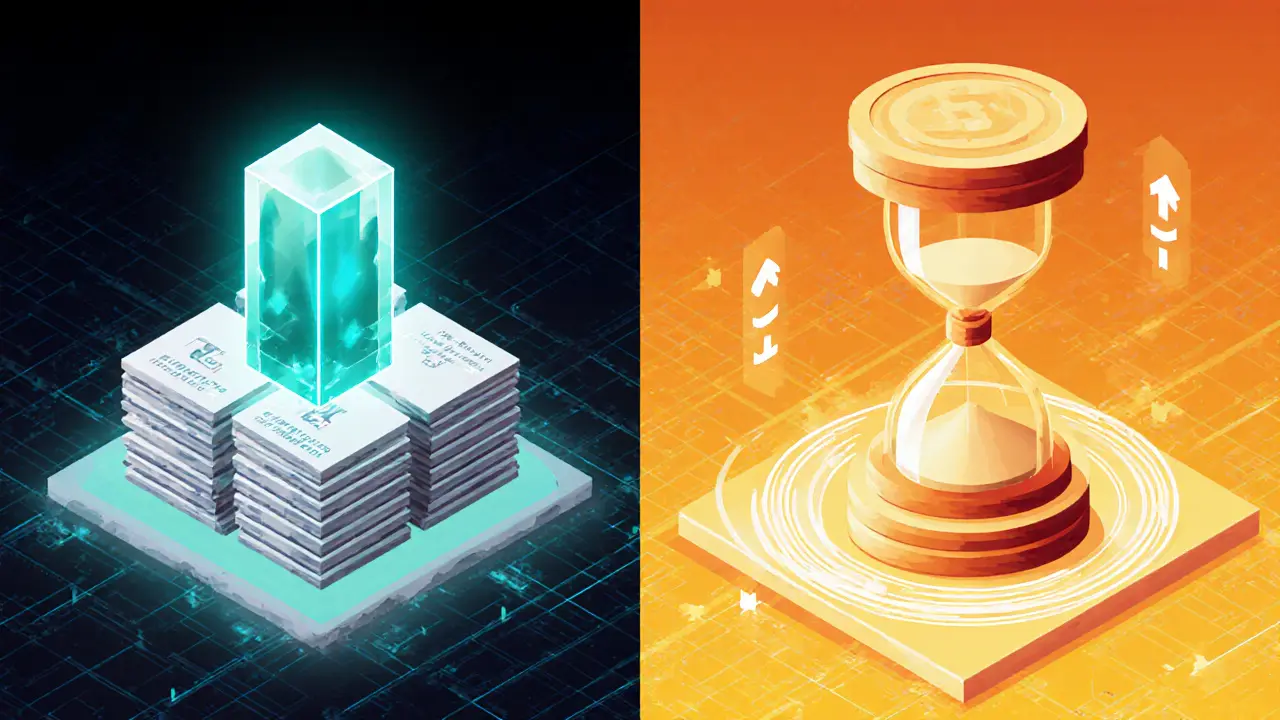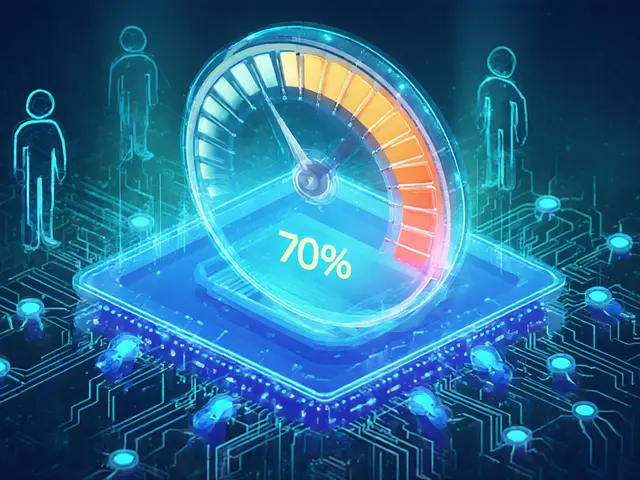Rollup Technology Comparison Tool
ZK-Rollup Instant Finality
Uses cryptographic proofs to validate transactions off-chain before submitting a succinct proof to the mainnet.
- Proof Type: Zero-knowledge SNARK/STARK
- Finality: Instant (seconds)
- Data Availability: On-chain (compressed)
- Best For: Payments, private transfers, high-frequency trading
Optimistic Rollup Delayed Finality
Assumes transactions are valid by default, only running full computation if challenged by a participant.
- Proof Type: Fraud-proof challenge
- Finality: Delayed (1-7 days)
- Data Availability: On-chain + challenger window
- Best For: Complex dApps, DeFi, NFT marketplaces
Choose Your Rollup Type
Recommended Rollup Type:
Key Attributes Summary
| Attribute | ZK-Rollup | Optimistic Rollup |
|---|---|---|
| Proof Type | Zero-knowledge SNARK/STARK | Fraud-proof challenge |
| Finality Speed | Instant (seconds) | Delayed (1-7 days) |
| Data Availability | On-chain (compressed) | On-chain + challenger window |
| Typical Use Cases | Payments, private transfers, high-frequency trading | Complex dApps, DeFi, NFT marketplaces |
| Cost per Transaction | Low (proof amortized) | Medium (gas shared, but dispute fees possible) |
When you hear the term rollup technology, think of a traffic controller that bundles dozens of cars into a single lane, letting them zip through a congested highway in one swoop. In blockchain, that “traffic controller” lives on Layer‑2, batching thousands of transactions into a single on‑chain proof, slashing fees and boosting speed while still leaning on the security of the main chain.
Rollup Technology is a Layer‑2 scaling solution that aggregates off‑chain transactions into a single data package submitted to a Layer‑1 blockchain. It emerged as a response to the chronic throughput limits of early blockchain networks and now powers most high‑throughput dApps.
Why Rollups Matter Today
- Transaction costs drop dramatically - a Bitcoin transfer that once cost 5,000satoshis can fall to about 50satoshis after rollup batching.
- Throughput jumps from a handful of transactions per second (tps) to tens of thousands, enabling real‑time gaming, DeFi, and NFTs.
- Security stays anchored to the underlying Layer‑1 (e.g., Ethereum or Bitcoin), so users don’t sacrifice safety for speed.
Two Main Flavors of Rollups
The ecosystem today revolves around two distinct designs, each with its own trade‑offs.
Zero‑Knowledge Rollups (ZK‑rollups) rely on cryptographic zero‑knowledge proofs that validate transaction batches off‑chain before a succinct proof hits the mainnet. The proof guarantees correctness without revealing individual transaction details, offering instant finality and strong privacy.
Optimistic Rollups assume transactions are valid by default and only run a full computation if someone challenges a batch. This optimism speeds up processing but introduces a dispute window (typically 1‑7days) before finality.
How Rollups Work Under the Hood
- Operators collect pending transactions off‑chain.
- They execute the transactions on a high‑speed side chain, updating the state.
- A cryptographic proof (either a zk‑SNARK/STARK or a fraud‑proof commit) is generated.
- The proof and a compressed data blob are posted to the Layer‑1 (mainnet).
- The mainnet verifies the proof, confirming thousands of transactions in a single step.
This flow decouples heavy computation from the base chain while preserving the base chain’s security guarantees.
Comparing ZK‑Rollups and Optimistic Rollups
| Attribute | ZK‑Rollup | Optimistic Rollup |
|---|---|---|
| Proof Type | Zero‑knowledge SNARK/STARK | Fraud‑proof challenge |
| Finality Speed | Instant (seconds) | Delayed (1‑7days) |
| Data Availability | On‑chain (compressed) | On‑chain + challenger window |
| Typical Use Cases | Payments, private transfers, high‑frequency trading | Complex dApps, DeFi, NFT marketplaces |
| Cost per Transaction | Low (proof amortized) | Medium (gas shared, but dispute fees possible) |

Emerging Trends Shaping the Future
While rollups already address the biggest bottlenecks, several research fronts promise to make them even more powerful.
- Better Compression: New data‑sharding schemes aim to shrink the on‑chain blob further, pushing tps into the hundreds of thousands.
- Hybrid Rollups: Projects are mixing zk‑proofs with optimistic assumptions to get instant finality for low‑risk batches and slower verification for complex logic.
- Cross‑Chain Rollups: Interoperable rollup bridges could let assets move between Ethereum, Bitcoin, and emerging L‑1s without leaving the rollup layer.
- Improved Fraud‑Proofs: Faster challenge mechanisms (e.g., multi‑round interactive proofs) aim to shrink optimistic rollup dispute windows to minutes.
- Regulatory Alignment: As governments study on‑chain data, rollups may become the preferred way to achieve auditability while preserving privacy.
Practical Adoption Checklist for Developers and Enterprises
Before you commit to a rollup, run through this quick checklist.
- Identify the security model you need - instant finality (ZK) vs. flexibility (Optimistic).
- Check compatibility with your target Layer‑2 ecosystem (e.g., Arbitrum, zkSync, StarkNet).
- Estimate gas savings: calculate batch size versus expected transaction frequency.
- Confirm data‑availability guarantees - does the rollup publish data on‑chain or rely on off‑chain providers?
- Review dispute mechanisms and legal implications for your jurisdiction.
Risks and How to Mitigate Them
No scaling tech is risk‑free. Here are the most common pitfalls and countermeasures.
- Operator Centralization: Choose rollups with many independent operators or decentralized sequencer designs.
- Proof Generation Costs: For ZK‑rollups, leverage batch‑size optimization and newer proving systems (e.g., PLONK).
- Challenge Spam: Optimistic rollups can suffer from malicious challenges; stake‑bond mechanisms help filter out bad actors.
- Smart‑Contract Compatibility: Ensure your contracts are audited for the specific EVM version used by the rollup.
Key Takeaways
- Rollups are the leading answer to blockchain scaling, cutting fees by up to 99%.
- ZK‑rollups deliver instant finality and privacy; Optimistic rollups excel at complex computations.
- Future improvements - better compression, hybrid models, and cross‑chain bridges - will broaden rollup adoption beyond Ethereum.
- Enter with a clear security, cost, and data‑availability checklist to avoid common traps.
Frequently Asked Questions
What exactly does a rollup do for a blockchain?
A rollup gathers many off‑chain transactions, executes them on a side chain, creates a compact proof, and posts that proof plus a tiny data blob to the main chain. The main chain only needs to verify the proof, which confirms thousands of actions in one step.
Are ZK‑rollups really private?
Yes. Zero‑knowledge proofs let the rollup prove that transactions are valid without revealing the underlying data. Observers see only the proof and the final state change.
Why do optimistic rollups have a delay?
Because they trust batches unless someone challenges them. The challenge window (usually a few days) gives participants time to submit fraud proofs if a batch contains an invalid transaction.
Can I use rollups on Bitcoin?
Bitcoin’s Lightning Network is a form of rollup that settles many micropayments off‑chain before recording the net result on‑chain. New on‑chain rollup proposals are also emerging to bring similar scaling to Bitcoin’s base layer.
What should a business look for when picking a rollup provider?
Focus on decentralization (multiple sequencers), proven security (audit reports), cost efficiency (batch size), and compatibility with your existing smart‑contract tooling.
Focus on decentralization (multiple sequencers), proven security (audit reports), cost efficiency (batch size), and compatibility with your existing smart‑contract tooling.







Mark Camden
August 8, 2025 AT 16:24Security should never be sacrificed on the altar of convenience; rollup designs that prioritize speed over provable correctness betray the fundamental principles of decentralization. ZK‑rollups, with their instant finality and cryptographic guarantees, embody the ethical standard we must demand from any scaling solution. Optimistic variants, while useful, introduce a trust window that can be exploited, and thus they occupy a secondary, conditional role at best. Developers and enterprises alike ought to adopt the most rigorous proofs whenever feasible, lest we erode the trust that underpins the entire ecosystem.
Evie View
August 14, 2025 AT 08:30Don’t be fooled by the glossy marketing hype surrounding rollups; the reality is that many projects are simply repackaging old inefficiencies with a shiny new name. The promised cost savings often evaporate when you factor in proof generation fees or dispute disputes. If you keep buying into every “next big thing,” you’ll end up with a patchwork of half‑baked solutions that jeopardize user funds. Enough is enough – demand transparency and real, measurable performance before you hand over any capital.
Kate Roberge
August 20, 2025 AT 00:37Everyone’s banging on about ZK‑rollups being the silver bullet, but let’s be real – they’re not a universal fix. The heavy proving circuits can become a bottleneck for complex DeFi contracts, and the ecosystem hasn’t fully ironed out data‑availability concerns yet. If you ignore the trade‑offs and just chase hype, you’ll bite off more than you can chew. So maybe stick with tried‑and‑tested optimistic solutions for now, at least until the zk‑tooling matures.
Oreoluwa Towoju
August 25, 2025 AT 16:44When choosing a rollup, start by listing your priority: speed, cost, or contract complexity. Match that list with the rollup that best satisfies the top item, and you’ll avoid over‑engineering.
Amie Wilensky
August 31, 2025 AT 08:50In the grand tapestry of decentralised computation, rollups emerge as threads of compression, weaving together myriad transactions into a singular, elegant proof; yet, one must ask: does this compression veil hidden externalities, or does it illuminate a path toward sustainable scalability? The answer, dear reader, lies not merely in throughput numbers, but in the philosophical commitment to trustlessness, a principle that, when breached, unravels the very fabric of blockchain integrity.
MD Razu
September 6, 2025 AT 00:57The evolution of rollup technology, when examined through the lens of historical scaling attempts, reveals a pattern of iterative refinement that mirrors the broader trajectory of computer science; initial solutions, such as simple sidechains, suffered from limited security guarantees, prompting innovators to explore more robust constructions. ZK‑rollups arrived on the scene, offering cryptographic proofs that, in theory, provide instantaneous finality without exposing transaction details, thereby addressing both privacy and verification concerns. However, the generation of these proofs is computationally intensive, and the associated costs, while amortised across batches, still pose a barrier to entry for smaller developers seeking to harness the technology. Optimistic rollups, by contrast, adopt a trust‑but‑verify paradigm, assuming transaction validity until a challenger presents a fraud proof, which introduces a dispute window that can extend from one to seven days. This delayed finality, while acceptable for certain DeFi applications, becomes problematic for high‑frequency trading or gaming scenarios where latency directly impacts user experience and financial outcomes. Moreover, the reliance on a single sequencer or a limited set of validators in many optimistic implementations raises concerns about centralisation and potential censorship. Emerging hybrid models strive to combine the best of both worlds, employing zk‑proofs for low‑risk batches while reserving optimistic verification for complex contract logic, thereby reducing overall latency without sacrificing security. In parallel, data‑availability solutions, such as data‑sharding and off‑chain availability committees, aim to minimise the on‑chain data footprint, enhancing throughput while preserving the ability to reconstruct state in the event of disputes. Cross‑chain rollups further expand the horizon, enabling assets to migrate seamlessly between disparate layer‑1 ecosystems, a development that could democratise access to liquidity and reduce fragmentation. Yet, each of these innovations introduces its own set of trade‑offs, be it increased protocol complexity, higher validator requirements, or nuanced governance challenges. The regulatory landscape adds another dimension, as authorities begin to scrutinise the opacity inherent in certain zk‑proofs, potentially imposing compliance mandates that could reshape the adoption curve. Practically speaking, developers must conduct rigorous threat modeling, assess the economic viability of proof generation versus transaction fees, and ensure that smart contracts are audited for compatibility with the chosen rollup’s virtual machine. In the end, the decision matrix for selecting a rollup is not binary but multidimensional, involving considerations of security, cost, speed, and ecosystem maturity. As the technology matures, we anticipate that the community will converge on standards that balance these factors, facilitating broader mainstream adoption without compromising the core values of decentralisation. Until then, a judicious approach-testing both ZK and optimistic solutions in controlled environments-remains the prudent path for innovators seeking to future‑proof their applications.
Charles Banks Jr.
September 11, 2025 AT 17:04Oh great, another rollup, because we clearly needed more layers.
Ben Dwyer
September 17, 2025 AT 09:10Nice breakdown of the pros and cons; if you keep testing both types on small pilots, you’ll quickly see which fits your app’s needs best.
Lindsay Miller
September 23, 2025 AT 01:17I get why security feels so important – keeping users’ money safe should always come first, no matter the tech.
Katrinka Scribner
September 28, 2025 AT 17:24Totally love the vibe! 😄 Rollups are like magic carpets for our crypto rides, omg sooo fast!!
VICKIE MALBRUE
October 4, 2025 AT 09:30Stay hopeful rollups will keep fees low and speeds high
Waynne Kilian
October 10, 2025 AT 01:37We should all try to share our experiences with both zk and optimistic rollups so the community can learn together, its like building a big puzzle piece by piece.
Naomi Snelling
October 15, 2025 AT 17:44They don’t want us to know that the real reason behind the hype is a covert consortium pulling strings to control transaction ordering and profit off the fees.
Michael Wilkinson
October 21, 2025 AT 09:50While your enthusiasm is noted, it’s critical to demand rigorous audits; any laxity could expose users to catastrophic loss.